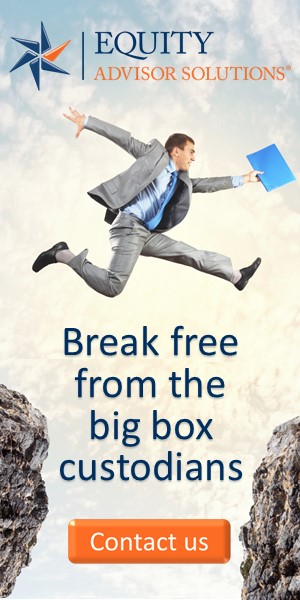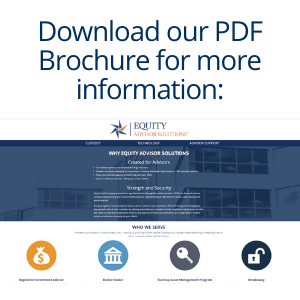When you first became an independent registered investment advisor, you probably didn’t realize you’d also be moonlighting as an IT manager, a technology systems integrator, web developer, data entry clerk, migration specialist, troubleshooter, and customer support representative!
Technology has become the backbone of a RIA’s business; it now helps with the heavy lifting required for trading, operational efficiency, data analysis, reporting, and client engagement. The events of 2020 solidified its importance in an advisor’s practice. More than 3 out of 4 North American financial advisors say they lost business during the pandemic because they lacked the right technology to interact with clients, according to a recent survey.[1] Conversely, advisors who used the crisis to update their tech say the upgrade has made clients happier.[2]
The trouble is, the more technology you fold into your practice, the harder it is to get everything to work together. Ask a group of independent RIAs to name their biggest operational challenge, and, chances are, the answer will be “integration.” Advisors see systems integration as the key to getting work done faster—including financial planning, proposal generation, customer acquisition, and other key activities.[3]. Fully integrated practices spend one-third less time on administration, and about 50% more time with their clients.[4] More time with clients results in happier clients. Happy clients refer friends!
The mandate facing advisors is clear: Upgrade and integrate your tech stack, now. The question is, how?
4 Keys to Choosing the Right Advisor Technology
The secret to solving this challenge is finding a platform that integrates with industry-leading products and services while combining state-of-the-art tools you need in one low-maintenance environment. An integrated platform should incorporate 4 crucial capabilities:
- Pro-level trading. Serving sophisticated clients with complex portfolios is increasingly impractical without an integrated suite of professional-level trading tools. These tools should allow efficient trading of all types of assets including alternative assets through a single platform, allowing advisors to trade at the individual, global and model level. Trading and rebalancing can be complex and time consuming. Advisors require tools that help streamline and make the process repeatable, custom and scalable. Advisors need to be able to customize portfolios to each client’s objectives while accounting for tax considerations.
Look for a trading suite that supports:
-
- Cloud-based trading
- Global trading
- Mutual fund, equity, and ETF modeling
- Optional next day settlement on equities/ETFs
- Multiple models in one account
- Short-term redemption fee warnings
- Streamlined operations. Technology is supposed to promote operational efficiency. In practice, keeping tech up to date and interoperable simply adds an extra layer of work for advisors. What advisors truly need are platforms that eliminate manual processes and seamlessly share data among multiple solutions, including:
-
- Portfolio management
- CRM
- Analytics
- On-demand money management
- Consumer-quality client portal. Lockdown taught Americans to live their entire lives via apps. Now, they expect their advisors’ client experience to measure up to Big Tech standards. The only practical way for small- to medium-sized advisors to meet this extraordinary new standard is to private-label a third-party portal. Check to see that the portal supports:
-
- Custom branding, featuring your brand logo, colors, and employee profiles
- Enhanced client engagement, including support for video, interactive portfolios and dynamic presentations
- A quality mobile experience
- Integrated Financial Planning Solution
- Custom branding, featuring your brand logo, colors, and employee profiles
- Sophisticated data analysis and reporting. Clients are asking tougher questions and looking for a deeper level of thinking from their advisors. A platform should assist advisors in demonstrating their value with features like:
-
- Advisor-branded presentations
- A choice of standard and easily customized reports
- GIPS composite performance reporting capabilities
- Benchmarking
- Asset classification
- Data aggregation
- Integration with other solutions such as CRM, financial planning, analytics, compliance, and research
- Advisor-branded presentations
Advisors need to understand that FinTech is accelerating. We are entering an era when technology is enhancing the client experience and exceeding their expectations. But for advisors, this utopian ideal may feel out of reach, as they struggle to make all of these exciting new tools work seamlessly together. It’s time for RIAs to demand that custodians and tech partners step up and take responsibility for creating more integrated solutions, so that they can get back to doing what they do best—serving their clients.
Advisors also need to understand that FinTech acceleration is making these tools common place at their competitors. Advisors need a provider who can help them compete!
[1] Source: Broadridge as reported in WealthManagement.com August 18, 2020. https://www.wealthmanagement.com/technology/broadridge-tech-tools-fall-short-leaving-advisors-sufferin
[2] Source: Asset Mark as reported in https://www.riaintel.com/article/b1nqds1qt5hrnx/growing-rias-aren39t-bluffing-clients-feel-let-down-and-want-new-advisors.
[3] Source: Aite Group, 2008.
[4] Source: Aite Group, 2007.
Custody and Administration Services provided by Equity Trust Company. Equity Advisor Solutions is an affiliate of Equity Trust Company. Equity Trust Company is a directed custodian and does not provide tax, legal or investment advice. Any information communicated by Equity Trust Company is for educational purposes only, and should not be construed as tax, legal or investment advice. Whenever making an investment decision, please consult with your tax attorney or financial professional.




